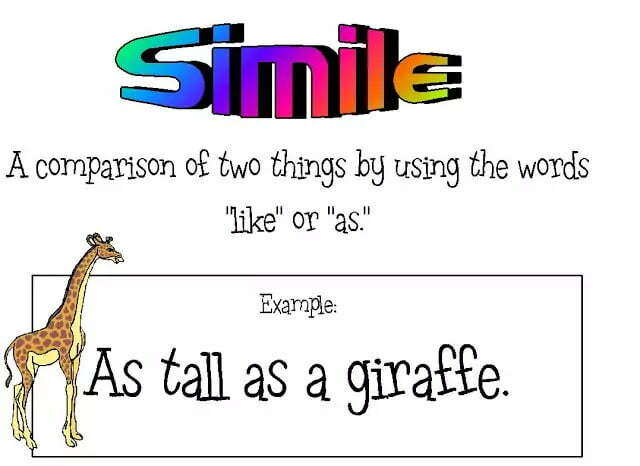
What is Simile?
Simile Meaning
Simile Definition
Simile Characteristics
- A comparison is made.
- The comparison is made between two unlike or dissimilar objects.
- The point of comparison is expressed or stated clearly.
- There must have the use of word of comparison, ‘like’, ‘as’.
Simile Examples
as blind as a bat | completely blind |
as cold as ice | very cold |
as flat as a pancake | completely flat |
as gentle as a lamb | very gentle |
as light as a feather | very light |
as old as the hills | very old |
as sharp as a knife | very sharp |
as strong as a bull | very strong |
as white as snow | pure white |
as wise as an owl | very wise |
like a rose | beautiful |
like a volcano | explosive |
like garbage | disgusting |
like an animal | inhuman |
like spaghetti | entangled |
like dewdrops | sweet and pure |
like gold dust | precious |
like a tip | very untidy (tip = garbage dump |
Examples in Literature
Popular songs, too, make use of simile
- A woman needs a man like a fish needs a bicycle – U2
- Cheaper than a hot dog with no mustard – Beastie Boys
- I must do what’s right, as sure as Kilimanjaro rises like Olympus above the Serengeti – Toto
- It’s been a hard day’s night, and I’ve been working like a dog – The Beatles
- Like A Rolling Stone – Bob Dylan
- Like a bat outta [out of] hell – Meat Loaf
- My heart is like an open highway – Jon Bon Jovi
- These are the seasons of emotion and like the winds they rise and fall – Led Zeppelin
- Thick as a Brick – Jethro Tull
- You are as subtle as a brick to the small of my back – Taking Back Sunday
Simile Types
Generally speaking there are four types of smile :
- Regular Simile
- Common Simile,
- Epic Simile
- Sustained Simile
Regular similes are those in which the number of compared objects does not exceed two. There is only one set of comparisons (love-leaves or knowledge-star) in such instances as follow:
Simile in Poetry
a.
a. She did me take love easy, as the
leaves grow on the tree. (Yeats)
b. And this gray spirit yearning in desire
To follow knowledge, like sinking star,
Beyond the utmost bound of human thought (Tennyson)
Common Similes are those which we unconsciously use in our everyday speech, and by virtue of their frequent use they have lost their freshness and become hackneyed,
Examples: as dry as bone, as proud as peacock, as poor as Church mouse
Epic Similes are those in which compared objects are described at length, and they frequently go beyond the point of comparison and present us a complete poetic picture of some scene or incident suggested by the comparison. What is important about such simile is that the pictures are so greatly expanded that the main point of comparison is often lost or thrown to the background, and many irrelevant details are introduced. Since such similes are common in Homer, they are also known as Homeric Similes. Here follow some examples
Simile Poems
(i) The broad circumference of [Satan’s shield]
Hung on his shoulder like the moon, whose orb
Through optic glass the Tuscan artist views
Or in Valdarno, to descry new lands,
Rivers, or mountains, in hor spotty globe. (Milton)
(ii) Like one that on a lonesome road
Doth walk in fear and dread,
And having once turned sound, walls on,
And turns no more his head;
Because he knows a frightful fiend
Doth close beside him tread. (Coleridge)
Sustained Similies are those in which two or more similies follow in
succession to illustrate same idea.
Simile Poems Examples
(a) My heart is like a singing bird
Whoso nest is in a watered shoot ;
My heart is like an apple tree
Whose boughs are bent with thickest fruit;
My heart s like a rainbow shell
That paddles in halcyon sea.
(C. G. Rossetti)
(b) O my love’s like a red, red rose
That’s newly sprung in June :
O my love’s like the melody
That’s sweetly play’d in tune. (Burns)
Function of Simile
The purpose of a simile is two-fold. It instructs while it appeals to our understanding. It pleases while it addresses to our heart. Dr. Johnson observes: “A simile, to be perfect, must both illustrate and ennoble the subject; must show it to the understanding in a clearer view and display it to the fancy with greater dignity, but either of these qualities may be sufficient to recommend it.”
Simile and Metaphor
Both the simile and the metaphor institute a comparison or show a similarity between two things or subjects, different in kind. But the comparison is not made in the same way in them. In the former, the likeness is clearly shown by the employment of the words like, as, like, etc. But in the metaphor, the resemblance between the things or subjects is kept implied.
Simile Worksheet
2. The Champak odours fall
3. Like a child form the womb, like a ghost from the tomb
I arise and unbuilt it again. (Shelley)
4. And we drop like the fruits of the trees.
I studied many of your examples of literary terms articles. they are quite practical.
thank you very very much, Mr. Sarkar.
Sincere Welcome
Wow, I learnt a lot!
Thank u